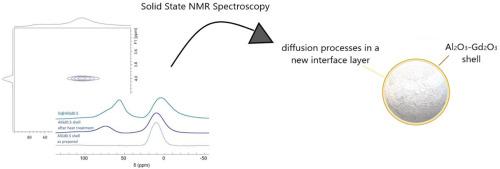Solid State Nuclear Magnetic Resonance ( IF 3.2 ) Pub Date : 2022-01-13 , DOI: 10.1016/j.ssnmr.2022.101773 Andrea Simion 1 , Mihai Vasilescu 1 , Claudiu Filip 2 , Milica Todea 3 , Marieta Mureșan-Pop 4 , Simion Simon 5

|
Atomic-scale description of surfaces and interfaces in core-shell aluminosilicate materials is not fully elucidated, partially due to their amorphous character and complex mechanisms that govern their properties. In this paper, new insights into nanostructured core-shell aluminosilicates have been demonstrated, by using different solid-state NMR methods, i.e 29Si, 29Si cross-polarization (CP), 27Al, 27Al triple-quantum (3Q), and 1H–27Al heteronuclear correlation (HETCOR) MAS NMR. For this purpose, nanostructured silica core-alumina shell microspheres, undoped and doped with gadolinium ions respectively, obtained by a chemical synthesis based on the Stöber method for the silica core and electrostatic attraction for developing the alumina shell were studied. As a result, a new alumino-silicate layer formation was proved at the interface between silica core, where aluminum diffuses, on small scale, in the silica network, and alumina shell, where silicon ions migrate, on a larger scale, in the alumina network, leading to a stable core-shell structure. Moreover, this process is accompanied by significant local structural changes in the transition zone, particularly at the aluminum neighborhood, which is quite well understood now, with the power of solid-state NMR spectroscopy.
中文翻译:

固态核磁共振光谱法表征二氧化硅核-氧化铝壳微球界面的结构
核壳铝硅酸盐材料中表面和界面的原子级描述尚未完全阐明,部分原因是它们的无定形特性和控制其特性的复杂机制。在本文中,通过使用不同的固态 NMR 方法,即29 Si、29 Si 交叉极化 (CP)、27 Al、27 Al 三量子 (3Q),证明了对纳米结构核壳铝硅酸盐的新见解,和1 H– 27铝异核相关 (HETCOR) MAS NMR。为此,研究了基于 Stöber 法的二氧化硅核和静电引力开发氧化铝壳的化学合成方法,分别获得了未掺杂和掺杂钆离子的纳米结构二氧化硅核-氧化铝壳微球。结果,证明了在二氧化硅芯和氧化铝壳之间的界面处形成了新的铝硅酸盐层,在该处,铝在二氧化硅网络中小规模扩散,在氧化铝壳中硅离子在氧化铝中大规模迁移。网络,形成稳定的核壳结构。此外,这个过程伴随着过渡区的显着局部结构变化,特别是在铝附近,现在已经很好地理解了固态核磁共振光谱的力量。


























 京公网安备 11010802027423号
京公网安备 11010802027423号